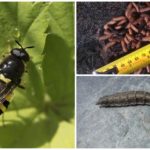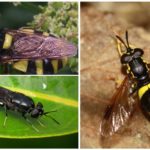Black lionfish flies and its larvae
- Black lionfish flies and its larvae
- Fly black lioness
In nature, there are several hundred species of flies, similar in color to the wasps. The lionwhite (Stratiomyia chamaeleon) is a fly belonging to the order of Diptera of the family of Levies (Stratiomyidae). Represents enough large yellow-black insectwhose body length reaches 14 mm. Outwardly, the lion's face is very similar to a bee, especially its flattened abdomen, colored with black and yellow stripes, catches the eye. However, neither sting nor poison it does not possess. Also, the fly has transparent wings and peculiar, having an annular last segment, antennae. It lives in a bright insect near water bodies and most often on flowering plants.Of particular interest are brownish-gray. fly larvae black lionfish that live in water.
Features of adults
Black lionfish fly has other names - Hermetia illucens or black soldier (Black Soldier Fly). Insects are found everywhere: more than a hundred species live in the forests of northern Eurasia alone. A large-scale production of larvae larvae in Russia has been established. The natural distribution area is North and South America.
Insect neither externally nor behavior is similar to its annoying relatives. Due to the lack of, or rather, poorly developed and exclusively designed for drinking mouth apparatus, the lionfish fly does not feed at all. The only occupation of the individual born is the procreation.
For individuals of the species of lionvine, the presence of features of sexual dimorphism is characteristic. There are no obvious sexual differences in males and females, although the latter are usually much larger. However, in most cases size of flies depends on the amount of food consumed by the larva, with the result that both males and females can have similar biometric indicators.
On a note!
After mating, the female lays from 5 to 8 hundred eggs in places where there is food for her future offspring. What takes no more than 7 days.
Larvae Features
After 3-5 days from the eggs laid by the female, small larvae appear in the world, their body length is about 3 mm. They are white, yellow or light brown in color. Their integuments are impregnated with calcium carbonate, which serves as a good protection both for the larvae themselves and for the pupae, which are subsequently formed inside the shell. Larvae usually live in ponds and soil, feed on detritus. Some species live in manure, rotting wood, in the nests of ants.
Nutrition
Of particular interest is the process of feeding the larvae of larvae, which differ in excellent appetite. They feed by means of a klyoobrazhnogo process on a small head and two moving serrated organs, resembling brushes. The coracoid process also performs another function: the larva clings to irregularities, which allows it to move along the bottom of the reservoir.
The food for the black fly larvae is everything that gets in their way: meat, fish, poultry and pig manure, the latter being more nutritious for them than horse and cow meat. By the quality of manure processing black larvae surpass even maggots dung-fly. Even unfermented fresh products are used, which distinguishes these creatures from ringed worms. The only thing they do not like is cellulose. In this connection, the worms are given “for reworking” compost after the larvae of the black lion cub fly.
On a note!
Larvae larvae are characterized by the highest density of colonization of the substrate. In one trash can of them there can be up to 100 thousand individuals, which resembles a huge pile of maggots. This amount in a matter of hours processes up to 95% of the edible mass.
Development
At the first stage of development, which lasts about two weeks (in the presence of favorable conditions), the larvae grow to 5 mm. At the second stage of formation, which takes about 10 days, they almost double in size. At the prepupal stage, the duration of which is about 8 days, the larvae of the black fly of the lion cubs reach 20 mm, change their color to dark brown. Their cover also becomes more dense and rigid.
The pupation process lasts about 1.5 weeks, as a result of which an adult individual is born, which mates and lays eggs.
About the benefits
This is one of the useful species of fliesused in agriculture. Black lionfish is an ideal candidate for mass production, since both the fly itself and its larva are rich in calcium and are a high-value substance and an excellent addition to the basic diet of poultry and animals. Moreover, in the process of such activities there is no waste, therefore, issues related to the disposal of hazardous organic waste are solved without problems.
Interesting!
Composting waste using the traditional method takes several years, recycling with the help of earthworms takes about 3 months. The larvae of the same black lioness, which is bred on food waste and manure, cope with this task for the week.
The black soldiers of the black soldiers themselves crush the waste, turning them into the smallest particles in the process of digestion. As a result, all nutrients are extracted from the mass of organic waste, and the total waste volume is reduced by 80%. And the waste itself is no longer such - it is a zoo-humus (high-value fertilizer).
In the natural environment, individuals at different stages of development become part of the natural diet of the fish, so they are often used by fishermen.Such food is also a favorite delicacy of chameleons. He goes on feeding reptiles, rodents, bats, aquarium fish, spiders and toads. The larvae are also made into flour, which is used to add to the feed. Sold such a valuable and useful raw materials by weight.
Another advantage is that flies are quite phlegmatic: they are quite easy to catch, even if they suddenly can leave the terrarium. Black soldiers are not considered as an unpleasant neighbor, since they are not at all attracted to the food and dwelling of a person.









